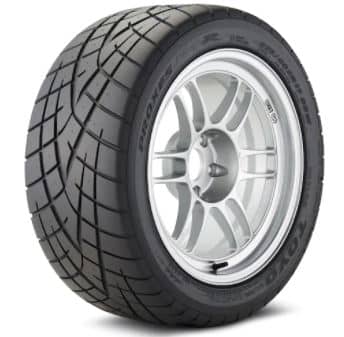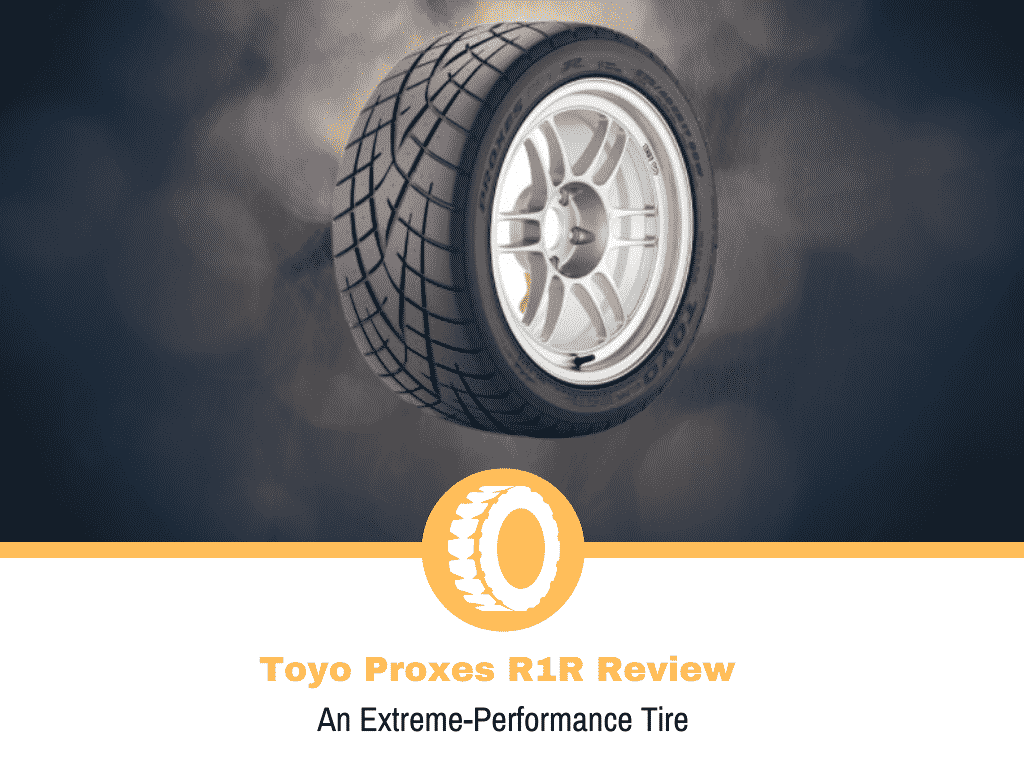
Price Check
Check the price of this tire at the following retailers:
Amazon TireRack DiscountTire Goodyear PriorityTire SimpleTireDon't know the correct size tire to purchase? Start here!
Pros
- Exceptional sporty handling
- Brilliant dry tarmac traction
- Above-average hydroplaning resistance
Cons
- Only warrantied for the first 1/32’’ wear
Toyo has finally turned the corner with the Proxes R1R. After years of producing tires for the most grueling conditions, the track, it has brought all that traction to the street. Driving enthusiasts couldn’t be happier as they finally have a tire that could bring out the best from their sports sedans and coupes.
Toyo Proxes R1R comes with everything racing tires are made of. It has advanced silica compounds that offer excellent traction in both dry and wet conditions. Its attractive tread design keeps straight-line stability, even when it attracts eyeballs with its eye-catching arrowhead shape.
Next come the shaped grooves that resist hydroplaning like a champ. Sandwiched between the tread blocks, the grooves are as nice to look as they are functional. They perform a fine job of pushing water from underneath the tire, helping the Proxes R1R maintain complete contact with the road.
All of this isn’t to say that this tire is faultless. Its loud noise, which gets louder as you press the pedal harder, might put off some potential customers. Especially those who are switching from all-season, touring, or grand-touring tires. Read Toyo Proxes R1R tire review for more.
What are the features of Toyo Proxes R1R?
Start with the silica-reinforced tread compound. As a reinforcing filler, silica helps this tire offer a unique combination of high fatigue resistance, low rolling resistance, and extreme fuel efficiency. Silica also expands at high speeds (due to high temperature), improving this tire’s road grip.

Then there is this tire’s radial construction. Compared to their diagonal counterparts, radial tires offer exceptional steering control and better road contact. Their flexible sidewall also enables them to maintain ride comfort and reduce rolling resistance, keeping your vehicle’s fuel consumption down.
Small wonder then that this tire boasts a 200 UTQG (Uniform Tire Quality Grading) rating. Sure, you could have tires whose UTQG rating is three or four times higher. But they won’t be extreme performance or even performance tires. Neither would they be as pocket-friendly as the Toyo Proxes R1R.
Next, look at its tapered center block edges. They perform two crucial functions. The first of which is imparting stability to this tire’s center block movement, something that keeps irregular wear at bay. Another thing they do is increase the Proxes R1R’s resistance to hydroplaning.
The Toyo Proxes R1R’s stability control slits also deserve credit for its excellent hydroplaning resistance. The wide spaces between the slits ensure that whatever number of water particles manages to get between this tire’s tread cannot stay there for an extended period.
How does it behave on dry tarmac?
The Proxes R1R performs brilliantly on dry tarmac.
You can count on this tire to react immediately to your steering’s input, highlighting the extreme performance aspect of this tire. It also communicates brilliantly with the driver, letting you immediately know which of the four tires have lost traction at the wheel.
Cornering performance is also top-notch, even if you’re fond of attacking tight bends and winding corners. You’ll never feel as if the tire is attacking the corner with any oversteer. At the same time, it isn’t excessively responsive to steering inputs, letting you cruise on the highway.
This tire’s braking performance leaves no prisoners, too, even if the dry tarmac is littered with dirt, dust, sand, and other debris particles. Its summer tread compound and stability control slits allow you to drive this tire hard and make sure it is more than willing to oblige to all your whims.
How does it behave on wet and slippery roads?
The Proxes R1R performs as well in wet conditions as it does on dry tarmac.
Moisture, oil, puddled rain, and contaminants do not affect this tire’s handling, cornering, and braking abilities. Thanks to its tapered control block edges, which effectively channel water from underneath the tire’s surface, any amount of water on the road won’t cause it to lose contact with the surface.
That this tire performs exceptionally on wet and slippery roads is a big deal. That’s because we aren’t talking about an all-season or touring tire here, which are wont to perform well in slippery conditions. Extreme performance tires suffer on wet roads, proving that the Proxes R1R is an exception.
For this reason, if you’re eyeing this tire for everyday driving, there aren’t many better options out there.
How is it over snow?
How does the Toyo Proxes R1R perform over snow?
This tire isn’t exactly the best choice for driving on snow- and ice-laden roads. Especially if you want to get safely from point A to point B in wet weather conditions. Slits, tighter-spaced blocks, and a soft-tread compound – features that are a must-have for winter tires – are absent here.
The last point should force you to think twice before driving this tire in wet conditions. A soft compound (something this tire doesn’t have) is essential to short braking distances on hard-packed snow and ice. Without it, this tire’s performance on snow might put your vehicle’s stability in danger.
All in all, I won’t be recommending this tire for cold weather conditions.
Is it comfortable and refined?
As comfortable and refined as extreme performance tires could be.
If you compare this tire’s ride quality and comfort with that of an exceptional all-season tire, like the Firestone Firehawk AS, it will lose in the comparison nine out of ten times. However, if you compare it with another extreme performance tire available for a similar price, its ride comfort might surprise you.
Toyo has equipped this tire with its proprietary Jointless Bead Technology. This technology aims to optimize the tire’s contact with the wheels at all times. This, in turn, enables this tire to cushion the ride, offering a more comfortable ride than most extreme performance tires in the same category.
As for noise, it shouldn’t come as a surprise that the Proxes R1R can get pretty loud, especially at high speeds for this tire. That might not be an issue for most people, though, given that this tire is rated at a maximum speed of 149 mph, a limit you can’t get near to without risking a pursuit by the police.
Is it good for off-roading?
The Toyo Proxes R1R isn’t good for off-roading.
Its silica-reinforced tread compound, aggressive tread design, and extra-wide footprint are meant to be used on paved roads and streets. This tire lacks the biting edges (sipes) and self-cleaning ability that enable all-terrain tires to offer the required traction on sand, mud, gravel, and rock.
Check out the Achilles Desert Hawk XMT if you’re really into off-roading.
Is the Toyo Proxes R1R ideal for sporty driving?
Here’s an area where the Proxes R1R upholds its manufacturer’s reputation.
As stated at the start of this article, Toyo has only recently decided to make road tires. Its specialty lies in producing tires that dominate the track, something you won’t find hard to believe after you have enjoyed this tire’s extreme handling, steering responsiveness, and cornering power.
The Proxes R1R ticks the one box all sporty tires must check: extreme grip on dry tarmac. The credit for this goes to its silica-reinforced tread compound, which causes the rubber to widen at elevated speeds, ensuring the tire retains an optimal level of grip for better handling during spirited driving.
Typically, irregular wear accompanies high-spirited driving, but you won’t have to worry about that with the Proxes R1R. Its tapered central block edge keeps the risk of uneven wear at a minimum by stabilizing the central block movement.
That said, the fact that this tire won’t suffer uneven wear anytime soon cannot be guessed by looking at its wear-warranty, one of the lowest on the market. More on this in the next section.
Toyo Proxes R1R Warranty
Toyo Proxes R1R’s wear-warranty covers it for the first 1/32’’ wear. No matter how you put it, it’s underwhelming, given that other extreme-performance tires are covered for the first 2/32’’ wear. The Goodyear Eagle F1 SuperCar 3 is a notable example.
What’s more, you don’t get any test drive warranty with this tire. Fortunately, though, you do get a 5-year workmanship and materials warranty with this product. But that is also 1-year less than what you get with extreme performance tires in this range.
Toyo Proxes R1R: Is it worth the money?
Starting at $137.43 for the smallest size, the Proxes R1R is a budget-friendly option for an extreme-performance tire. The price could get even lower if you have any discount codes for retailers selling it. Based on this, it could be said that the Proxes R1R is definitely worth its asking price.
Should I buy the Toyo Proxes R1R?
If you can keep peace with the fact that it’s only warrantied for the first 1/32’’ of wear, I see no other major reason why this tire doesn’t deserve your money. Its dry road handling, wet road grip and hydroplaning resistance and budget-friendly asking price all go in its favor.
What Vehicles Will the Toyo Proxes R1R fit?
Here’s a sample of models that the Proxes R1R will fit:
- Mercedes-Benz C300
- Ford Fiesta Hatchback
- Mini Hardtop 2 Door Cooper
- Mazda Miata
Tire Sizes for Toyo Proxes R1R?
15”
- 195/55 R15
- 195/50 R15
- 205/50 R15
16”
- 205/55 R16
- 205/50 R16
- 205/45ZR16
17”
- 215/45ZR17
- 225/45ZR17
- 235/45ZR17
- 255/40ZR17
18”
- 225/40ZR18
- 245/40ZR18
- 265/35ZR18
List of Toyo Tire Reviews



